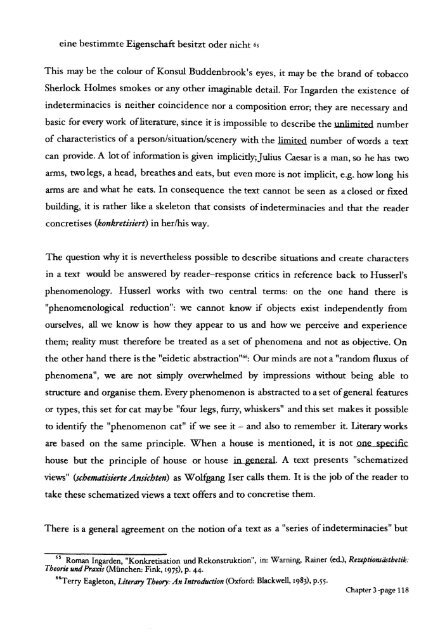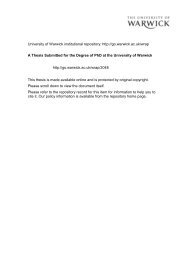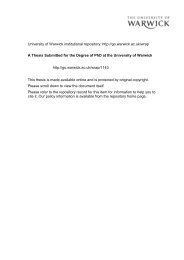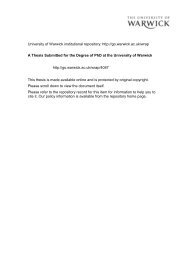From Page to Screen - WRAP: Warwick Research Archive Portal ...
From Page to Screen - WRAP: Warwick Research Archive Portal ...
From Page to Screen - WRAP: Warwick Research Archive Portal ...
You also want an ePaper? Increase the reach of your titles
YUMPU automatically turns print PDFs into web optimized ePapers that Google loves.
eine bestimmte Eigenschaft besitzt oder nicht 65<br />
This may be the colour of Konsul Buddenbrook's eyes, it may be the brand of <strong>to</strong>bacco<br />
Sherlock Holmes smokes or any other imaginable detail. For Ingarden the existence of<br />
indeterminacies is neither coincidence nor a composition error; they are necessary and<br />
basic for every work ofliterature, since it is impossible <strong>to</strong> describe the unlimited number<br />
of characteristics of a person/situation/scenery with the limited number ofwords a text<br />
can provide. A lo<strong>to</strong>f information is given implicitly;Julius Caesar is a man, so he has two<br />
arms, two legs, a head, breathes and eats, but even more is not implicit, e.g. how long his<br />
arms are and what he eats. In consequence the text cannot be seen as a closed or fixed<br />
building, it is rather like a skele<strong>to</strong>n that consists ofindeterminacies and that the reader<br />
concretises (konkretisiert) in herlhis way.<br />
The question why it is nevertheless possible <strong>to</strong> describe situations and create characters<br />
in a text would be answered by reader-response critics in reference back <strong>to</strong> Husserl's<br />
phenomenology. Husserl works with two central terms: on the one hand there is<br />
"phenomenological reduction": we cannot know if objects exist independently from<br />
ourselves, all we know is how they appear <strong>to</strong> us and how we perceive and experience<br />
them; reality must therefore be treated as a set of phenomena and not as objective. On<br />
the other hand there is the "eidetic abstraction'l". Our minds are not a "random fluxus of<br />
phenomena", we are not simply overwhelmed by impressions without being able <strong>to</strong><br />
structure and organise them. Every phenomenon is abstracted <strong>to</strong> a set ofgeneral features<br />
or types, this set for cat maybe "four legs, funy, whiskers" and this set makes it possible<br />
<strong>to</strong> identify the "phenomenon cat" if we see it - and also <strong>to</strong> remember it. Literary works<br />
are based on the same principle. When a house is mentioned, it is not one specific<br />
house but the principle of house or house in general. A text presents "schematized<br />
views" (schematisierte Ansicbten) as Wolfgang Iser calls them. It is the job of the reader <strong>to</strong><br />
take these schematized views a text offers and <strong>to</strong> concretise them.<br />
There is a general agreement on the notion ofa text as a "series ofindeterminacies" but<br />
65 Roman Ingarden, "Konkretisation und Rekonstruktion", in: Warning, Rainer (ed.), Rezeptionsdstbetik:<br />
Theone undPraxis (Miinchen: Fink, 1975), p. 44.<br />
66Terry Eagle<strong>to</strong>n, Literary Theory: An Introduction (Oxford: Blackwell, 1983), P·55·<br />
Chapter 3 -page 118





